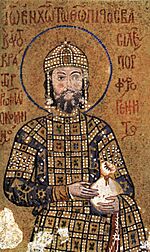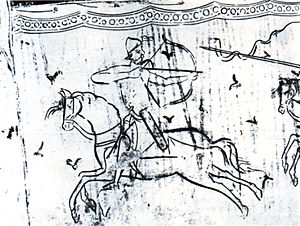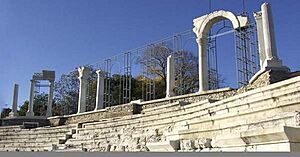Battle of Beroia facts for kids
Quick facts for kids Battle of Beroia |
|||||||
|---|---|---|---|---|---|---|---|
| Part of Byzantium under the Komnenos dynasty | |||||||
 Emperor John II Komnenos, commander of the Byzantine forces in the battle. |
|||||||
|
|||||||
| Belligerents | |||||||
| Byzantine Empire | Pecheneg Khanates | ||||||
| Commanders and leaders | |||||||
| John II Komnenos | Unknown | ||||||
| Strength | |||||||
|
Unknown
|
Unknown | ||||||
| Casualties and losses | |||||||
| Unknown | Unknown | ||||||
The Battle of Beroia was a big fight in 1122. It happened near a city now called Stara Zagora in Bulgaria. The battle was between the Pechenegs and the Byzantine Empire. The Byzantine army was led by their emperor, John II Komnenos. He ruled from 1118 to 1143. The Byzantines won this battle. After their defeat, the Pechenegs stopped being a separate, independent group of people.
Why the Battle Happened
The Pechenegs were a nomadic group from the steppes. They had fought the Byzantines before. In 1091, Emperor John II's father, Alexios I Komnenos, had defeated them. Many Pechenegs were forced to join the Byzantine army. Other groups were attacked by the Cumans in 1094. But some Pecheneg groups remained independent.
In 1122, these Pechenegs crossed the Danube River. They invaded the Byzantine Empire. Some historians think the ruler of Kiev, Vladimir Monomakh, might have encouraged them. The Pechenegs had once helped him. This invasion was a big threat to the Byzantines. Emperor John II Komnenos decided to act. He moved his army from Asia Minor, where they were fighting the Seljuk Turks. He brought them to Europe to stop the Pechenegs.
The Battle of Beroia
Emperor John II gathered his soldiers near Constantinople. He wanted to meet the Pechenegs quickly. The Pechenegs had already crossed the Haemus Mountains, also known as the Balkan Mountains. They set up camp near the city of Beroia in Thrace.
At first, the Emperor tried to trick the Pecheneg leaders. He offered them gifts and a good peace treaty. The Pechenegs believed him. This allowed the Byzantines to surprise them. The Byzantines suddenly attacked the Pechenegs' wagon fort. This fort was called a laager. It was made of wagons linked together for defense.
The Pechenegs were skilled horse archers. They fired many arrows. Their laager was important for them. It was a safe place to gather and get more arrows. It was also their last line of defense. The fighting was tough. Emperor John was even wounded in the leg by an arrow. But the Byzantines pushed the Pechenegs back into their fort.
The laager was strong. It was hard for the Byzantines to break through. Finally, Emperor John led his best soldiers forward. These were the Varangian Guard. They were an elite group of heavy infantry. The Varangians carried large Danish axes. They hacked their way into the Pecheneg wagon fort. This broke the Pecheneg defenses. Their camp fell apart, and they ran away. The Byzantines won a complete victory. The Pecheneg survivors were captured. Many of them were then made to join the Byzantine army.
What Happened Next
The Byzantine victory at Beroia was very important. It meant the Pechenegs were no longer an independent group. Some Pecheneg communities stayed in Hungary for a while. But over time, they blended in with other groups. They became part of the Bulgarians and Magyars.
For the Byzantines, this win brought more control over the Balkans. This allowed Emperor John to focus on other areas. He could now work on making Byzantine power stronger in Asia Minor and the Holy Land. Even though the Hungarians attacked later in 1128, the victory over the Pechenegs helped secure the Byzantine Empire's borders.
See also



